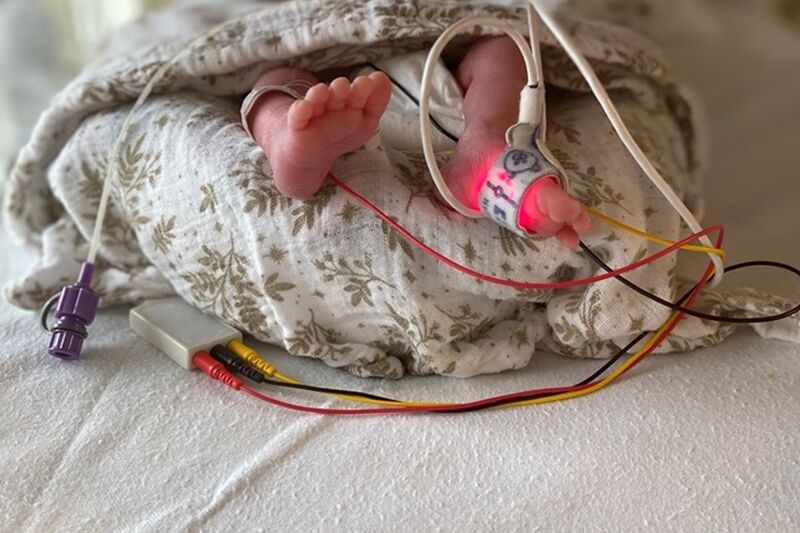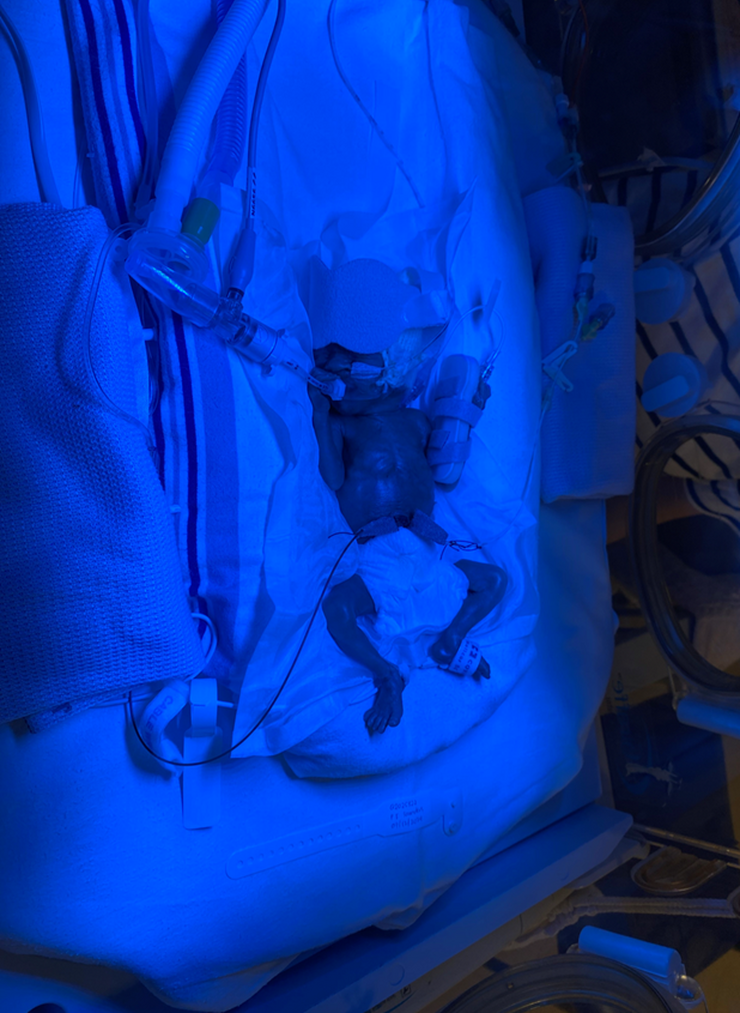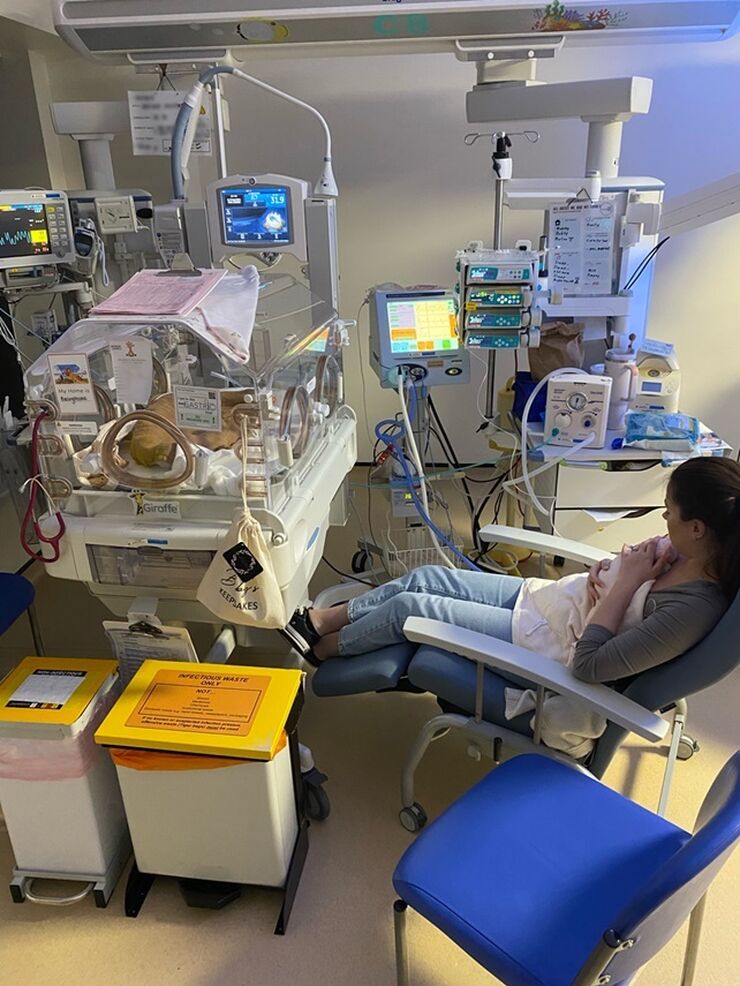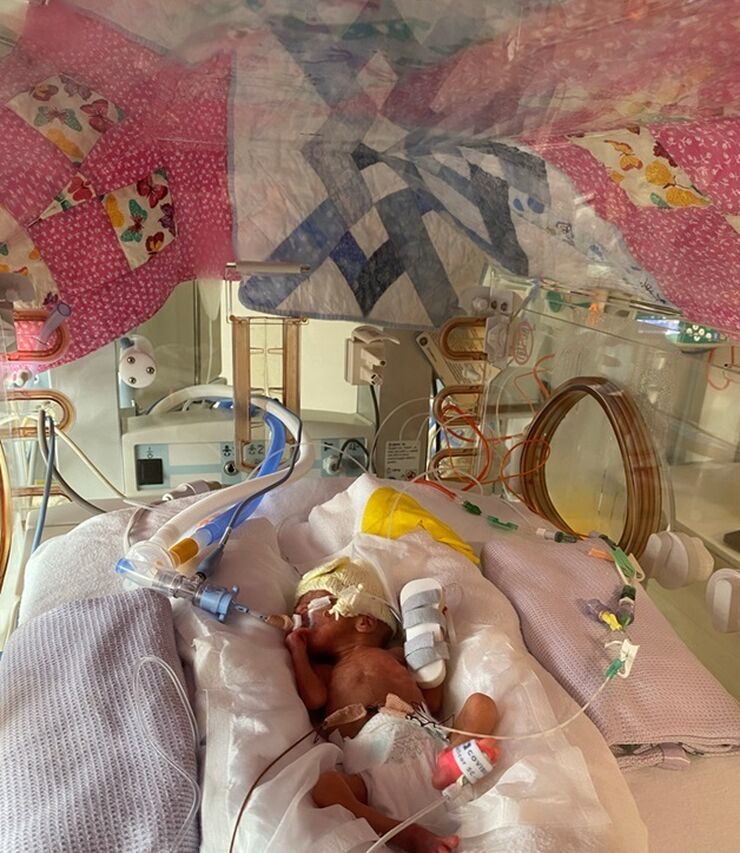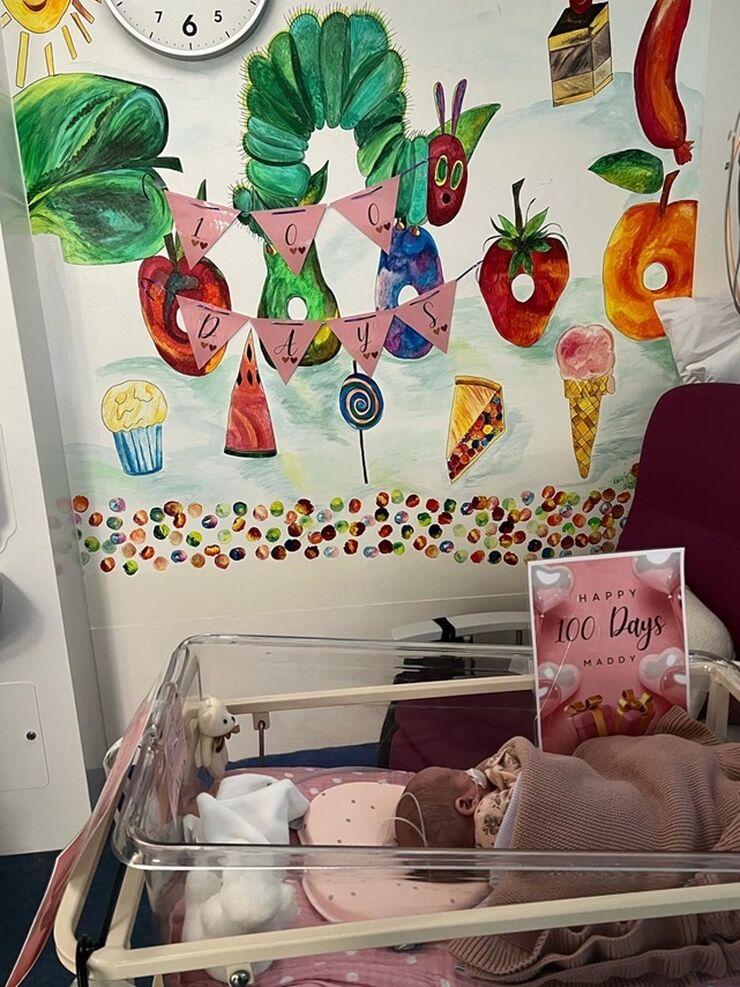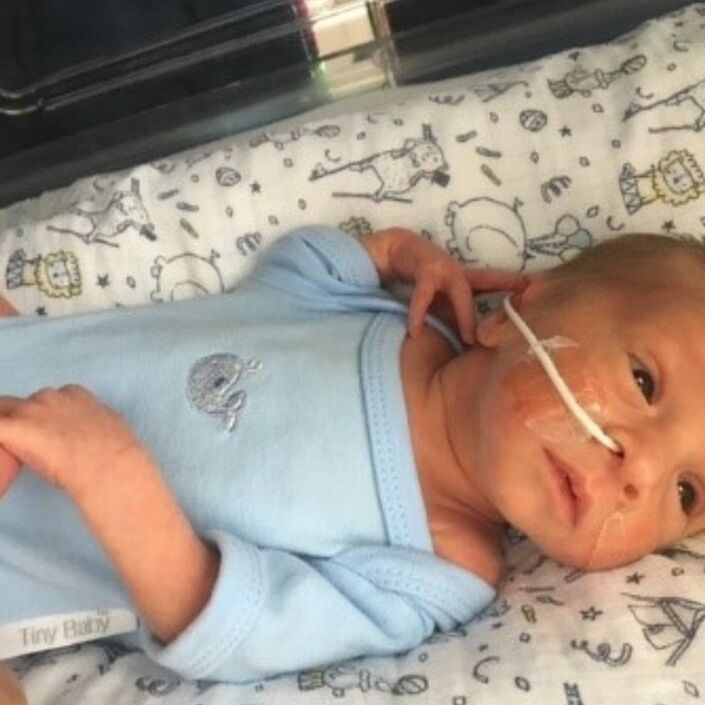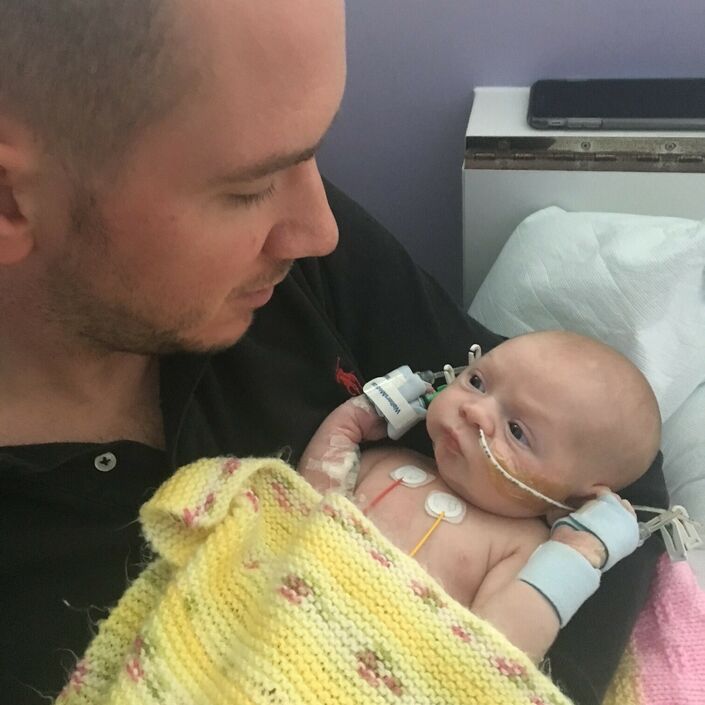Delivery day
After 3 weeks in maternity units my wife’s health began to deteriorate due to early indications of an infection brewing, therefore there was a consensus to intervene and induce labour at 23 weeks 6 days gestation in December 2024. My wife suddenly showed signs of delivery so the midwife pulled the emergency cord which triggered a flurry of medical teams running into our delivery suite including the neonatal retrieval team. In the back of my mind, I was conscious we were short of the viability threshold, but the neonatal team had briefed us previously they would perform a preliminary assessment known as APGAR in order to determine the best course of action for our daughter, as we would not want to cause any unnecessary suffering.
Our daughter was delivered within her amniotic sac, albeit along with the placenta detached thus compromised. The neonatal team began efforts to intubate her on the resuscitaire, given her heart rate had dropped to 60. She was assessed and had an initial APGAR score of 1 out of 10 (a term baby is normally 7-9). Fortunately, she was a fighter and was trying to breath on her own despite her lungs not being fully developed. She was stabilised before being rushed out the room to the NICU all within 7 minutes. The room which was once at full capacity began to empty and it had all seemed a blur.
Once my wife was well enough, we were able to visit our daughter in the NICU. The sheer size of her was astounding, nothing prepares you for seeing a baby that small weighing just 488g (1lb 1oz). She was laid on a silk sheet within an incubator and we were not allowed to touch her due to her being very delicate and high-risk of infection. She was also on a ventilator and had also been subject to medical procedures to enable the them to monitor her vitals, provide medication and nutrients.
Life inside QAH NICU
A week prior to our daughter’s birth we were offered a tour of the NICU as it can be quite a daunting place packed with specialist equipment and of course the infamous frequent beeping sounds. There are three areas made up of Neonatal Intensive Care Unit (Level 3), High Dependency Unit (Level 2) and Special Care Baby Unit (Level 1). Full or pre-term babies who are unwell after birth would typically reside within intensive care. In practical terms as babies progress and become less dependent on intensive care, they are moved to the lower units and in the words of the nurses are a step closer to graduation.
Throughout our daughter’s stay she was diagnosed with respiratory distress syndrome (RDS), bronchopulmonary dysplasia (BPD) / chronic lung disease (CLD), multiple collapsed lungs, osteopenia / metabolic bone disease (MBD), apnea (AOP) which caused copious apnea and bradycardia events, anaemia (AOP), stage 1 retinopathy (ROP), multiple infections, jaundice, problematic sugar levels and gastro oesophageal reflux disease (GORD). She also had endless amounts of cannula’s inserted into her tiny veins, arterial lines, long lines, countless blood gases, blood transfusions (we stopped counting when we hit double figures in the first month alone) and lumbar punctures. She even dislodged her ventilator ET tube on two occasions which resulted in reintubation. The sight of the red resuscitation trolley on standby getting unpacked isn’t a pleasant experience, we left the room at that point.
One of the most difficult parts was seeing other babies being admitted and subsequently moved to the less dependency units after just a few days stay in intensive care, whilst we knew little Madison was going to be a long term resident. There are however some good memories, such as the first time you are able to hold your baby, we had to wait over one month for this moment and it was a bit different than expected.
Another milestone was coming off the ventilator which our daughter had been on for 6 weeks and moved onto the next breathing machine BiPAP. It took two attempts in the end as during the initial attempt unbeknownst at the time she was fighting an infection, therefore became tired after 24 hours and had to be reintubated. During the second attempt she did really well and after one week on BiPAP, she was moved to CPAP for a single day prior to jumping ahead to high-flow as she was over achieving much to everyone's surprise.
Every morning a team of neonatal Doctors led by a Consultant Neonatologist would carry out their ward rounds to set the daily strategy plans for each of the babies. They are without doubt geniuses, we often thought of their job as having to spin multiple plates at one time to optimise care and mitigate risks. We had to trust a stranger with the care of our daughter, but we never had reason to doubt and we knew the whole team by now.
Christmas & New Year’s Eve
Tis’ the season to be jolly, but it was clearly going to be a bit different this year as we entered our seventh week in hospital. Madison decided to open her eyes for the first time on Christmas Eve. On Christmas day we arrived to find a plethora of gifts for Madison and my wife from the NICU as well as charities and also parents who had been in our position the previous Christmas. Madison even had a visit from Hampshire Fire Service, albeit I think my wife was more excited by this.
Whilst we were not at home enjoying a few beverages with family and friends, we were still able to enjoy a Christmas meal in the hospital canteen courtesy of a charity Sophie’s Legacy. We could always make up on lost time in due course, our priority right now was our daughter. We were thankful for the neonatal nurses, after all they had given up spending time with their families to care for ours.
A week later at midnight on New Years, we shared a few bottles of Nozeco with the neonatal nurses courtesy of Madison who in her great wisdom thought it would be a nice treat for all to enjoy, whilst watching fireworks go off in the distance over Portsmouth.
Long-term plan, logistics & support
It would be remiss of us to fail to mention the logistical impact this journey would have on us, as a round trip of 130 miles was not practical. Where were we going to stay, how long for and what about work? Unfortunately, QAH does not have a Ronald McDonald house. There are some basic parent rooms, but these were allocated to mums on a temporary short-term basis whose babies were closer to leaving the unit. In the end despite the hefty price tag, we decided the best solution for long-term was to stay in a local hotel and an Airbnb both a short walk away.
At the time of writing the UK Government did not offer any support to parents of premature babies, despite guidance and supporting evidence from the NHS that parents being present helps with their development. We did however learn of the Neonatal Care (Leave and Pay) Act which came into effect from 6th April 2025 and meant both parents of a baby in neonatal care by Law would be entitled to 12 weeks of statuary leave and pay. This was too late for us to benefit from, therefore our paternity and maternity was spent in hospital, which left us feeling like we had been robbed. I also had to begin working remotely partly from the hospital and also our accommodation, scrambling around with a laptop, but I counted myself fortunate I worked remote, as many other Dads were unable to be present.
Within the NICU there are a number of internal supporting departments separate from the rest of the hospital including physiotherapists for babies and a team of counsellors and psychologists available for parents. There is also a dedicated feeding team on hand to help mums who are expressing every three hours 24/7 as premature babies are fed via a tube and MEBM is most beneficial, therefore there was a lot of pressure on Madison’s mum to provide milk every 3 hours, which she did continuously for over 3 months.
We encountered several charities along the way including Bliss, The Smallest Things and Ickle Pickles which were all useful for educating us and also enabled us to learn about other parents experiences. Last but by no means least Sophie’s Legacy, who provide much needed support to the families and their children whilst in hospital which we benefited from. From the parent box awaiting us on our first day, to the Saturday night pizza, through to the check-in calls, it was nice to know others were looking out for us. The work all these not-for-profit charities do is incredible and never did we ever think we would be on the receiving end.
Transfer day
In February 2025 it was clear our daughter had turned a corner and could now be considered for a transfer to our local neonatal unit back in Basingstoke which we were able to visit for a tour ahead of the move. We were relieved to get going however were also cautious given Madison had not left the intensive care room at QAH before. That said this would now mean we could live at home again whilst tending to her care. Things were looking up however it’s never that straight forward and due to an unstable night the decision had been made Madison needed to remain at QAH longer.
We were gutted to say the least, however accepted if she was not ready to be transferred so be it. However, on the plus side for Madison, new extra large drawers were installed in her bay, which meant her mum could acquire even more clothes. She had a reputation of being a fashionable neonate.
In March 2025 at 37 weeks gestation a specialist ambulance (SONeT) facilitated by Southampton and Oxford hospitals was arranged to take us on the next leg of our journey. Madison was three months old and was leaving QAH for the first time. Several staff members who had cared for our daughter throughout her stay whom we had built a good relationship with had gathered to see us off.
